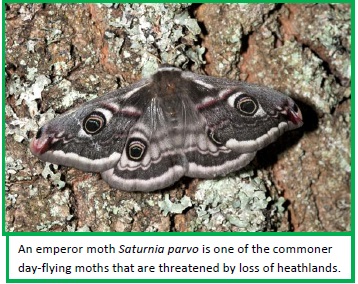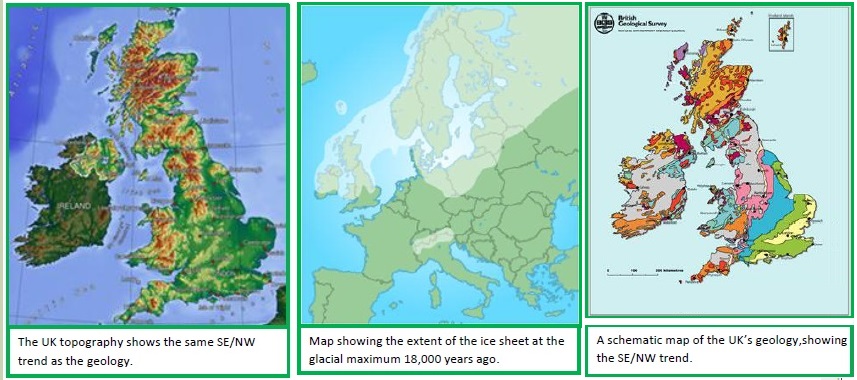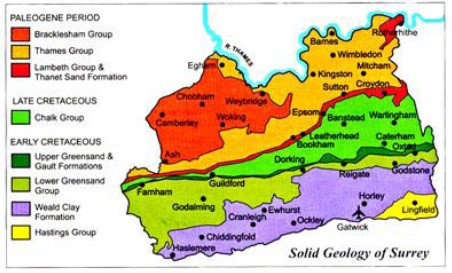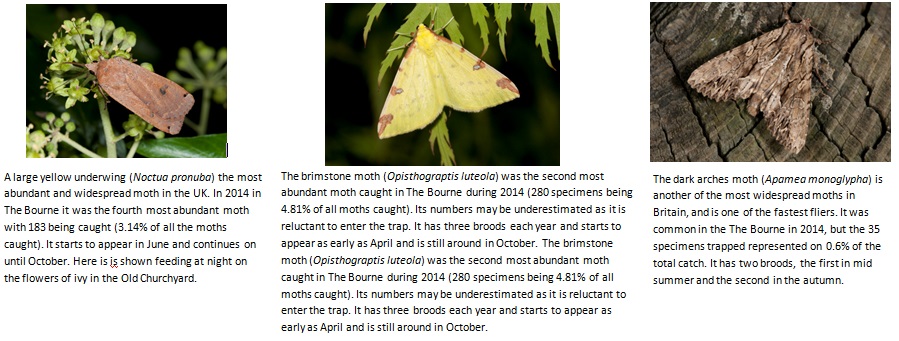![]()
![]()
Biodiversity and BCG Introduction ?Variety is the spice of life?, and biodiversity is the expression of this variety ecologically. The Bourne Conservation Group is committed to protecting and enhancing the biodiversity of our local area. So it is important not only that we understand what we are about, but also how we can optimize our efforts.
Definition of Biodiversity Fundamentally biodiversity is an expression of how many species of plants and animals there are. However, this number varies according to the scale you are looking at ? both in time and in space. On a global scale the numbers are vast, but they progressively reduce as the focus is reduced in scale down to Europe, to England, to Surrey, to The Bourne, to your garden, to your wood pile. It also changes in time, from geological time scales to millennia, to centuries, to decade to year to year and seasonally. So if you clear a patch of ground it quickly gets re-colonised by a variety of plants and animals. The plants are familiar to us as weeds in the garden. The patch then undergoes a progressive change as the weeds are replaced by shrubs like brambles, and these in time give way to trees and so eventually the patch becomes woodland, and this final assemblage of species is called the climax community. This process may take centuries to achieve and even then a climax community is far from static; fresh species move in and even the species themselves can change evolutionarily. This natural change is termed the ecological succession. As the plants change so do the animals. The exact sequence of the succession is determined by what was there before (i.e. the seed bank), and what is in the surrounding areas and so is available to spread in. Some plants are better at dispersing than others, so in The Bourne one of the trees that spread in very rapidly is sycamore. On the heath-lands around us it is birch that spreads in the quickest. Mankind is now a factor in the species that arrive, both by introducing alien species and by changing climate and so making our environment suitable to a different set of species.
Measuring Biodiversity The simplest way of measuring biodiversity is merely to list and count the number of species. Although compiling a simple inventory of species is a start, it is far from providing the whole picture. Consider these three samples of six carpet moths.  Clearly example 1 is the most diverse in that it contains the six different species. But which is more diverse out of examples 2 and 3 both of which consist of two species? In example 2, the species are divided evenly between the two species, whereas in example 3 there are still two species but the sample is dominated by the barred yellows. So example 2 is considered to be more diverse than example 3 (scientifically there is a greater chance of sampling a second species by random from example 2 than for example 3). Hence high diversity also implies that the species are more evenly divided between the component species and that the community is not dominated by a single (or few) species.
Clearly example 1 is the most diverse in that it contains the six different species. But which is more diverse out of examples 2 and 3 both of which consist of two species? In example 2, the species are divided evenly between the two species, whereas in example 3 there are still two species but the sample is dominated by the barred yellows. So example 2 is considered to be more diverse than example 3 (scientifically there is a greater chance of sampling a second species by random from example 2 than for example 3). Hence high diversity also implies that the species are more evenly divided between the component species and that the community is not dominated by a single (or few) species.
Managing biodiversity  Each stage of the succession is typified by a different assemblage of species. Some of our rarest species are reliant on ancient, long-established ecosystems. The ancient oaks in Windsor Great Park support a whole suite of rarities. This is one reason why we should be protecting and conserving our ancient woodlands and forests. But many of our ecosystems and their associated species are in danger of being lost unless we manage them properly. For example the heaths around Frensham Pond must be kept from reverting to birch woodland if we are not to lose not only national rarities such as sand lizards, Dartford warblers and woodlarks, but also some of the commoner species that are becoming rarer as a result of habitat loss.
Each stage of the succession is typified by a different assemblage of species. Some of our rarest species are reliant on ancient, long-established ecosystems. The ancient oaks in Windsor Great Park support a whole suite of rarities. This is one reason why we should be protecting and conserving our ancient woodlands and forests. But many of our ecosystems and their associated species are in danger of being lost unless we manage them properly. For example the heaths around Frensham Pond must be kept from reverting to birch woodland if we are not to lose not only national rarities such as sand lizards, Dartford warblers and woodlarks, but also some of the commoner species that are becoming rarer as a result of habitat loss.
The skill is in interfering with the natural processes just enough to maintain their diversity. Hence we as a group help to clear holly from Burnt Hill and Paradise Woods, and stop invasive species like laurel and Himalayan balsam from dominating the sites we manage. Having a wide mix of plants will ensure a wide mix of insects and other invertebrates, many of which are important in the diets of our birds and bats. We approve the clearance of pines from The Bourne Woods and the Gong Hill RSPB reserve, and the use of cattle to graze the local heathlands for similar reasons. By creating a mosaic of habitats at different stages of the natural succession the local biodiversity is maximised.
Biodiversity in the UK Locally one of the most important environmental factors controlling biodiversity is the underlying geology. Very different species of animal and plant are to be found on chalk and limestone than on clays and granites. A glance at a map of the geology of Britain shows that it is highly varied. Topography is also important – mountains support very different faunas and floras to lowlands. In the UK topography shows a similar south-east/north-west pattern which not only corresponds to the geology (and age of the rocks) but also has a strong influence on climate. In the west the climate in the west is more maritime (milder and wetter) than in the east which is more continental (drier and greater seasonal An emperor moth Saturnia parvo is one of the commoner day-flying moths that are threatened by loss of heathlands. A schematic map of the UK?s geology, showing the SE/NW trend. extremes). One effect of these gradients is a marked difference in phenology ? the name give to the study of seasonal events. In Britain, Spring starts in the south-west and spreads north and east ? finally arriving several weeks later in the North of Scotland. Conversely the onset of autumn starts earlier in the north and spreads southwards. So the growing season is far longer and leaves stay on the trees longer in the south than in the north. Looking down from the air (or looking at Google maps) we see a mosaic of patterns; these are determined partly by the geology of the landforms (hills, plains, rivers, valleys) and partly by the impacts of Man?s activities. Many of these patterns have their origins in the impact of the ice cover during the glaciations, but there is an increasingly evident overlay of human activity – the seemingly chaotic patterns of towns, villages, roads railways, farms and woodlands. However, these too have been influenced by the geology and the topography. Villages are spaced out at a distance that approximates to how far a Man can walk in an hour. Our network of main roads reflects the pattern of the old coaching roads that avoided regions where the coaches would get bogged down. So now in our area the main roads run radially from London and there are relatively few circumferential roads, especially across the Wealden clay regions. Even the southern course of the M25, which provided the first main trunk route to get around London, follows the geology ? in this case the edge of the chalk escarpment of the North Downs. Each element within countrywide pattern has its own fauna and flora. Another major significant influence on the UK?s biodiversity is the persistent imprint of the last glaciations, which ended about 18, 000 years ago. The ice sterilised vast areas of the north of the country, and when it melted left behind superficial coverings of gravels (moraines and drumlins). Its impact on our local river, the Wey in creating a series of river captures, is described in the Geology section of this web site. The UK topography shows the same SE/NW trend as the geology. Map showing the extent of the ice sheet at the glacial maximum 18,000 years ago. The maximum extent of the ices cover is shown above, but what this map does not show is that at the time of the glacial maximum the English Channel did not exist. When it opened up about 11,000 years ago, it became a barrier to the northwards immigration of land animals following the retreat of the ice. Hence our fauna and flora remained less diverse than those of France and the Low Countries, similarly the fauna and flora of the UK tends to be lower south of the line between the Severn and the Wash, which approximates to the southern limit of the ice cap.

Biodiversity in Farnham and The Bourne As can be surmised from the above paragraphs, the subset of the UK fauna and flora that Surrey enjoys is relatively rich, and Farnham is also favoured with a rich inventory of species. This results partly from the complex geology of our region which gives rise to many soil types. Within walking distance of Farnham (and The Bourne) the terrain changes from chalk down-land, to acid heath-land, to pastureland, to woodland growing on Wealden clay, and the flood plain of the River Wey. The Farnham branch of the River Wey is a chalk stream as it rises on the chalk near Alton. These habitats are each inhabited by assemblages of animal and plant species, which have relatively little in common.
UK fauna Surrey Fauna The Bourne fauna Hymenoptera
(bees and wasps) 600 490 ?200+ Butterflies 59 42 26 Macromoths 800 540 309 Micromoths 1600 1130 205 Grasshoppers and crickets 35 30 19
 Signs of human impacts are evident everywhere. The stone tools of Stone Age hunter/gathers have been found in The Bourne. The influence of the monks of Waverley Abbey pervaded the area in the Middle Ages, when they created wetlands like Frensham Pond. At much the same time a series of water mills were built along the Wey which resulted in considerable alterations to the course of the river and its feeder streams. In the 16th and 17th century a number of a deer forests were created including Farnham Park, which is a remarkable protected area in North Farnham (insert URL), and another key protected area within the town is Bishop?s Meadow (insert URL). The Enclosure Acts changed land-use of the nearby heaths as recorded in Cobbett?s Rural Rides and later in Sturt?s accounts of The Bourne. The coming of the railways and the expansion of Aldershot as the home of the British Army, dramatically affected our area. The Farnham Gravels were exploited, and more and more large houses were built in and around The Bourne. Scots pines were planted in Bourne Woods to provide timber to support the war efforts in the last century especially in supplying pit props to the coal fields. Local agriculture was focussed on hop-growing for the local breweries. Hop growing ceased to be profitable in the area partly because of a fungal disease and the costs of mechanising harvesting. Subsequently The Bourne has become dominated by suburban sprawl, but we still benefit from the network of pathways, which originated as access to the many gravel workings, large gardens, and nuggets of protected land, like the Old Churchyard, Paradise Wood, Burnt Hill Wood, Spire wood, Bourne Woods and Compton Field.
Signs of human impacts are evident everywhere. The stone tools of Stone Age hunter/gathers have been found in The Bourne. The influence of the monks of Waverley Abbey pervaded the area in the Middle Ages, when they created wetlands like Frensham Pond. At much the same time a series of water mills were built along the Wey which resulted in considerable alterations to the course of the river and its feeder streams. In the 16th and 17th century a number of a deer forests were created including Farnham Park, which is a remarkable protected area in North Farnham (insert URL), and another key protected area within the town is Bishop?s Meadow (insert URL). The Enclosure Acts changed land-use of the nearby heaths as recorded in Cobbett?s Rural Rides and later in Sturt?s accounts of The Bourne. The coming of the railways and the expansion of Aldershot as the home of the British Army, dramatically affected our area. The Farnham Gravels were exploited, and more and more large houses were built in and around The Bourne. Scots pines were planted in Bourne Woods to provide timber to support the war efforts in the last century especially in supplying pit props to the coal fields. Local agriculture was focussed on hop-growing for the local breweries. Hop growing ceased to be profitable in the area partly because of a fungal disease and the costs of mechanising harvesting. Subsequently The Bourne has become dominated by suburban sprawl, but we still benefit from the network of pathways, which originated as access to the many gravel workings, large gardens, and nuggets of protected land, like the Old Churchyard, Paradise Wood, Burnt Hill Wood, Spire wood, Bourne Woods and Compton Field.
Biodiversity in The Bourne today It is difficult to get a comprehensive picture of biodiversity in The Bourne, because there are so few local people who take an active interest in identifying and recording our species. Many species are tricky to identify and require a level of expertise (e.g. bats, spiders, flies, and bees) that takes time to acquire. In addition there are year-to-year changes in weather patterns and species? abundances, which make it far too easy to miss the occurrences of species. So whereas the arrivals of spectacular novel species are relatively easily to detect, the local extinctions are very difficult to establish. During the last decade or so the BCG has been in existence we have seen the arrival of several new species (tree bumblebee, harlequin lady bird, ivy bee, landhopper, the western conifer seed bug), but we have only detected the local extinction of a single species (the great green bush cricket). 
The richness of the biodiversity in The Bourne can be exemplified by the moths of which 314 species of macromoth and 232 species of micromoth (as of April 2014) have been recorded over the last five years. Similarly a partial survey of Compton Field carried out in 2013 in order to present a case that the field should be conserved as green infrastructure showed it to be inhabited by 141 plant species, 11 mammals, 17 birds, 18 butterflies, 105 moths, 28 bees and wasps, 30 beetles, 6 dragonflies, 39 flies, 47 bugs, 12 spiders 20 miscellaneous other invertebrates. Many of these and other groups (beetles, spiders, flies, bees, molluscs soil fauna) have been grossly under-sampled so these figures are misleadingly low.
Threats to our Biodiversity There are many threats to our national biodiversity, but here we focus just on the local threats.
1. Urban spread A pervasive threat is urban spread. The growth in our national population is threatening biodiversity nationally and locally. There is a pressing need for more houses to be built along with the concomitant needs to provide the necessary infrastructure (schools hospitals, communications, water, sewerage services etc). This is leading to serious loss of habitats and the increasing loss of green pathways along which species can move and re-occupy habitats where catastrophic local events such as flooding have resulted in local extinctions. Some of the new arrivals in The Bourne over the last few years: – A. The tree bumblebee; B. the harlequin lady bird; C. The ivy bee: D. The landhopper: F. The western conifer seed bug.
2. Garden grabbing Planners and developers tend to regard gardens as a waste of space. In Farnham gardens occupy 20-25% of the town?s area. However, the importance of domestic and public gardens to the health and well being of the human population as well as Nature has been well demonstrated. A survey BCG conducted of Gardens in and around The Bourne demonstrated just how important our gardens are to the local wildlife.
3. Application of chemicals Chemical treatments as pest control of agricultural crops and garden plants are having serious impacts on our pollinators and are poisoning our waterways. The decline in honey bee populations is likely to be, at least partially, because of chemicals used as agricultural seed treatments and pest control. Metaldehyde, which is the active component of slug pellets, is getting into our water supplies. It is causing concern because it is a chemical that cannot be removed by water treatments. The hormones used in contraceptive pills are causing problems in many aquatic species making them infertile.
4. The introduction of invasive non-native species This problem has been highlighted through the introduction of certain invasive plant species, such as Japanese knotweed, Himalayan balsam, some rhododendrons and laurel. These plants spread rapidly and because they arrive without natural controls (diseases and consumers). They become the dominant components in natural communities and so exclude many of our native species. In the 1970s we saw the drastic alterations in our landscapes resulting from the introduction of Dutch elm disease. Most of the large elm trees that were a defining feature of our countryside either died or were felled to try and stop the spread of the disease. Now we are faced with the possibility of similarly disastrous introductions and spread of diseases that threaten oak and ash trees. Substantial losses of oak trees would have a particularly savage effect on our biodiversity since over 700 species of invertebrates are dependent on oaks.

5. Climate Change Our natural communities are adapted to our normal weather cycles. If the predicted changes in our weather (hotter drier summers, wetter milder winters, and more violent extremes) our fauna and flora will be radically changed. Many species respond to warmer conditions in Spring, but activities of others are physiologically tied to day length and do not change as the climate warms. This is upsetting the ecological balance of our communities; thus the nesting times of birds, which are timed so that their eggs hatch just as the maximum abundances of food for the nestlings becomes available are liable to become mistimed. There is also a tendency for geographical distributions to extend Example of biodiversity unfriendly hedge planting: – A newly planted laurel hedge in Old Church Lane on the left and on the right along Green hill Road, and example of the gloomy depressing feature totally lacking in any other plants it will become within a few years if not managed. northwards. We have already seen the appearance of the wasp spider in our area; a species that until recently was restricted to southern coastal areas.
The role of The Bourne Conservation Group Our group can play a significant local role in the conservation of our local biodiversity and thereby play a small role in conserving biodiversity nationally, by:-
1. Monitoring and recording what species are to be found in the area. Change can go undetected until it is too late to reverse it.
2. Making everyone aware of what of the riches we enjoy will help to ensure that species are not allowed to be eliminated through ignorance as the general environmental pressures increase, particularly as a result of the nation?s need for more housing and improved infrastructure.
3. Managing our sites to ensure they continue to support a rich diversity of plants and animals.
4. Disseminating information about what individuals can do to conserve biodiversity, such as what garden plants are most beneficial to insect pollinators. 5. Working with other local groups to our mutual benefit.
6. Playing a role in the elimination of alien plant species that threaten our biodiversity.
7. Continuing to comment on the environmental impact of new developments to try to ensure that good practise is adopted by developers, and monitoring that restrictions are adhered to.
8. By emphasising the importance of biodiversity to the general public and to children through publications, lectures and running training courses.
9. Collaborating with other local organisations, such as Surrey Wildlife Trust, the Bishops Meadow Trust and the Friends of Farnham Park, in assisting with and upholding biodiversity projects in The Bourne and the wider Farnham area.
Moths Count Newsletter Contributed by Martin Angel There are various newsletters on the web that are gold mines of interesting information. This one, produced by Butterfly Conservation for 2014, I found particularly interesting www.mothscount.org/downloads/95/updates_and_newsltters.html. It gives some results of the National Moth Recording Scheme, which now includes over 17 million records. 2.4% of the observations are for large yellow underwings, 1.5% for heart and darts and dark arches. Dividing the whole of the British Isles into 10km squares shows that the large yellow underwing occurs in 56% of the squares, Silver Y?s in 54%, brimstone moths and dark arches in 52%. There has been a steady increase in the percentage of square occupied by the five most widespread moths from 1990 to 2002, but most species have declined. There is a report on how Dutch moths are in considerable decline; 39 species are known to have become extinct in the 20th Century and 20 more have not been seen so far in the 21st century. The much feared Oak Processionary moth has expanded its distribution in Holland and is now spreading in Britain.
The National Moth Night this year is scheduled for 10th-12th September. There is an article on using sex pheromones to explore the distributions of some of our most elusive species, like some of the clearwing species. There is a report on the Munching caterpillar project (www.munchingcaterpillars.org) ? an ideal project for schools. Another citizen science project is reported at www.conkertreescience.org.uk. The Horse Chestnut Leaf Miner, which arrived in Britain in 2002 originating in Greece, and has been spreading 25 miles per year. It has now extended north of Newcastle; it reduces the size of conkers by 15%! Its rapid spread is in sharp contrast with the results reported in the section on moth mobility. Mobile species could travel up to a kilometre in a week, but the smaller weaker flying species (like the chestnut leaf-miner) moved only a few tens of metres. Experimental observations of tethered moths flying capabilities showed that copper underwings are capable of flying up to 31km (at 2.8mph), large yellow underwings 30km (at 6mph) and dark arches 19km (at 7.4mph). Smaller moths are restricted to less than 50m. Long distance moth migrations such as conducted by silver Y?s which annually migrate in the spring from Southern Europe to the UK and return back south again in the autumn, exploit the winds that blow at heights of 500m. These sorts of results are important in establishing how best to establish ?green corridors? effectively to link protected areas.

![]()
All content ? Bourne Conservation Group 2008
